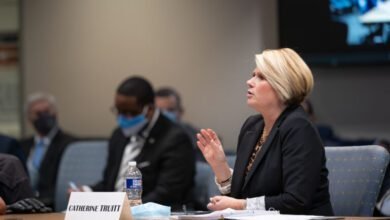The Learning Curve: A Crash Course in the ‘Science of Reading’

When I started as an education reporter for Voice of San Diego, I didn’t know much about education. So, like any good reporter, I did some research. That’s how I came across American Public Media’s “Sold a Story” podcast. This exposed me to one of the most important conflicts I had never heard of: the “reading wars.”
At their core, they are a battle between methods for teaching children to read and have been around for decades.
In one corner are practices like whole language and balanced literacy models that, although they are based on flawed strategies, have been ubiquitous in schools across the country. In the other corner are practices that have proven to be effective and more fully incorporate what we have learned from the body of research called the science of reading.
For years, the “reading wars” were largely an academic debate among educators, but more recently they have gained prominence thanks in large part to captivating reports like “Sold a Story.” The podcast set off a firestorm that confirmed what many researchers, educators and parents have known for years: We have been teaching children to read wrong.
While this realization is frightening and likely explains why so many children across the country are not reading at grade level, there is good news – we know how to teach children to read.
Ever since I heard “Sold a Story,” I’ve been wanting to investigate how local schools are teaching reading and whether they’ve dropped the ball like so many schools across the country. I’ll talk more about this later – but first, I had to better understand the science of reading. Let’s get into it.
What is the science of reading?
The science of reading is not so much a curriculum as an interconnected body of research that encompasses fields ranging from neuroscience to developmental psychology to linguistics and everything in between. Through this work, researchers were able to better understand not only how children learn to read, but also how best to teach them.
One important thing to keep in mind is that learning to speak and learning to read are very different processes. Over millennia, human brains have developed an innate capacity for speech, so much so that learning to speak can be a kind of unconscious process.
Written language, on the other hand, is a much more recent development that our brains have not yet fully caught up with. So this doesn’t happen as naturally, so it’s vital that educators have the right tools.
Many of the criticisms of approaches to teaching children to read that rely on the science of reading are that they are something of a one-trick pony that focuses exclusively on phonics instruction. While research-backed methods certainly incorporate phonics and encourage children to sound out words in ways that other methods cannot, there is much more to these approaches than just just phonetics.
The science of reading, on the contrary, shows that learning to read is a delicate mix of skills that must be balanced.
The reading string: One way to think about these skills is to use a string – or a “reading string,” to be more specific. This metaphor was created by psychologist and researcher Hollis Scarborough to demonstrate that the ability to read comprises a set of separate but related skills. In metaphor, these skills can be separated into two groups: language comprehension and word recognition.
Language understanding, for example, includes things like vocabulary, prior knowledge, and linguistic structures. The word recognition bucket includes skills such as being able to recognize sounds in written and spoken language, being able to recognize familiar words by sight, and being able to decode words themselves. Only when each of these threads is intertwined will children become skilled readers.
Although many children learn to read without much difficulty, many others will not. Schools – and parents – must be prepared to teach them, and to do so armed with strategies that have been proven to work, not the flawed systems that have failed so many children. This is a very broad overview of just some of what the science of reading has taught us. Digging deeper into the weeds would require many thousands more words than a newsletter would allow.
And if this all sounds complicated to you, you’re right, it is. The good news is that we know what works and there are resources available. Reporter Emily Hanford, whose journalism, both in “Sold a Story” and in written form, has shaped much of this conversation, has put together a great list of resources. Some of them are very dense, but they are all thought-provoking. Give it a read and tell me what you think.
Content bouncing around my mind palace
California State Superintendent Tony Thurmond is pushing a bill that would provide California teachers and aides with new training on how to teach math and reading, making specific reference to the science of reading. There’s one problem: There’s no price tag attached, and given the state’s funding crisis, it’s unclear where the money would come from.
Warner Unified, a small school district in rural east county, spends $12,000 a year on bottled water. This is because the district has had unsafe levels of arsenic in its drinking water for more than a decade. Despite searching for solutions, the district hasn’t made much progress.
For more than a year, parents lobbied San Diego Unified to change the name of Henry Clay Elementary, named after a 19th-century Kentucky politician and slave owner. On Tuesday, the district’s Board of Education approved the change, voting unanimously to rename the school Dr. Bertha O. Pendleton Elementary School in honor of the first Black woman to serve as the district’s superintendent. Despite praising the change, some parents are still resentful of what they see as a lack of transparency in the process.
What are we writing
Over the years, schools have adopted different methods to teach children to read. But in the latest installation of The Progress Report I detailed how one organization is adopting research-backed methods to help children at four schools in southeast San Diego learn to read – and how that work is paying off.
Poway Unified Superintendent Marian Kim Phelps has been under fire since November, when students and parents alleged she had harassed members of the Del Norte High School softball team, on which her daughter plays. The harassment allegedly stemmed from an incident in May at a softball team banquet during which some members failed to applaud Phelps’ daughter. Now, the district board has voted unanimously to remove her, writing in a statement that an investigation into her conduct produced evidence that contradicts statements she made to the public and district officials.




